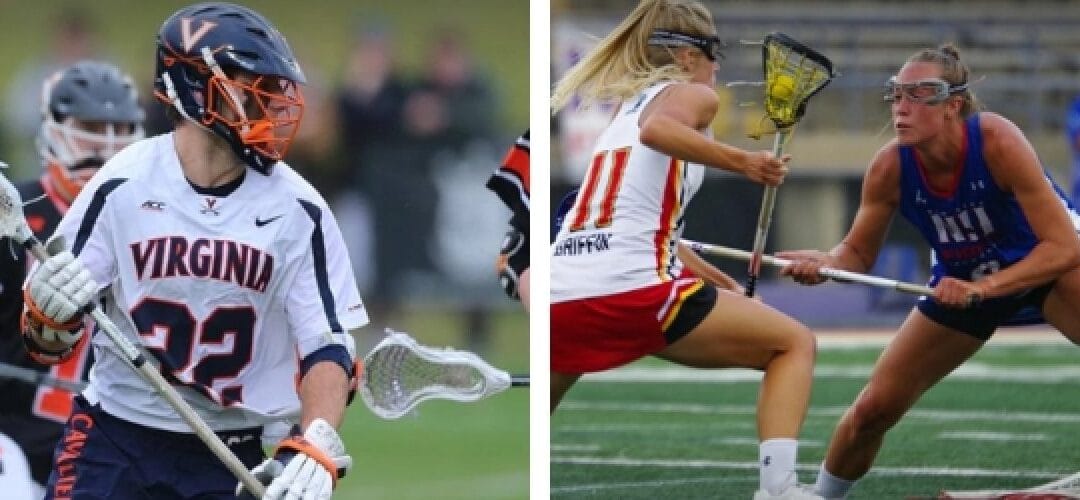(Photos by University of Virginia and University of Maryland lacrosse)
By Paul Culp, MA (Oxon.), CFT, GCDF, CCSP
Don’t believe everything you hear about a full ride, but don’t lose heart either.
Welcome back to our series on athletic scholarships. We began with The “How Many” and “How Much” of Athletic Scholarships (September 18, 2018) and then went sport-specific with Women’s Volleyball Scholarships by the Numbers (October 10) and Women’s Soccer Scholarships by the Numbers (October 23). After pausing to catch our breath, we covered the scholarship search process and the recruiting scene in The “How To” of Athletic Scholarships Explained (November 24). Not surprisingly, if you know much about college athletics, that last one was one of the most complex topics we’ve ever written about. We haven’t been bashful about recommending our own services to aspiring college athletes, because pursuing a scholarship is a lot like painting the Sistine Chapel ceiling: It puts you among some of the world’s great saints and sinners, and one clumsy move can make things really messy.
Among other things, we’ve established that there’s a lot of money out there, for a lot of athletes, and that women actually receive more generous funding per athlete than men do. We also have pointed out, however, that a scholarship in most sports–including lacrosse–is divisible among as many athletes as the coach wishes to include, which means that full athletic scholarships are rare. Most athletes who do receive scholarships have to market themselves diligently to reach that goal, because very few can just sit back and wait to be discovered, and clinics and combines and tournaments primarily benefit athletes with whom coaches are already familiar.
Those are some of the general truths that should serve as background for an exploration of the opportunities for lacrosse players of both sexes.
9:1 and 609
According to ScholarshipStats.com, there are 113,313 male high school lacrosse athletes and about 96,904 female high school lacrosse athletes in the U.S. At the college level, 15,257 men and 12,732 women play lacrosse. While about 12.5 percent of high school lacrosse players go on to compete collegiately, the numbers fall sharply for NCAA Division I, a level reached by only 3.3 percent of women and 2.5 percent of men. While the odds of competing at any college level are 9:1 for both sexes, men have a 39:1 shot in Division I, with women at 30:1 odds. NAIA totals are 639 men and 513 women, with the numbers for the NJCAA being 727 and 306 respectively.
A total of 609 colleges have lacrosse programs: 125 in Division I, 115 in Division II, 302 in Division III, 38 in the NAIA, and 29 in the NJCCA. That’s right: roughly half of all college lacrosse programs are in Division III, where there are no athletic scholarships. That doesn’t mean that lacrosse prowess is irrelevant to the financial aid possibilities at those schools, however. They might even prove to be the best deal of all. We’ll be returning to this topic shortly.
Women’s programs outnumber men’s programs considerably: There are 440 programs for men and 562 for women, and only in the NJCAA do men’s programs have a numerical edge, 33 to 28. The discrepancy is largest in Division I, with 72 for men and 115 for women. Even so, men significantly outnumber women.
The average size of a women’s team in the NCAA is less than two thirds that of a men’s team, with the discrepancy narrowing by about ten points in the NAIA and NJCAA. The scholarship limits are about the same, however, with men’s programs getting roughly one more scholarship per program at most: 12.6 for men vs. 12 for women in Division I, 10.8 vs. 9.9 in Division II, 20 apiece in NJCAA, and no limits in NAIA.
Pie that pays for books…
Now, about those scholarships:
Most high school student-athletes and their parents don’t realize that very few athletic scholarships constitute full free rides. Only a handful of sports in the NCAA–not including lacrosse–are head count sports, meaning each available scholarship is assigned to only one athlete, for the full amount. The rest, and all athletic scholarships in the NAIA and NJCAA, are equivalency sports, meaning the coach can divide each scholarship into as many slices as s/he sees fit.
Taking Division I as an example, the average lacrosse scholarship is about $12,000 for men and $13,000 for women, but the average roster size is 44 for men and 30 for women, and the pie can be sliced many different ways. On average, D1 schools are dividing their dozen or so scholarships among more than 30 athletes. Some athletes may be fully funded, others partially funded to greatly varying extents, and still others unfunded. The largest reported men’s lacrosse scholarship was $17,483, and the largest for women was $22,842. The low end was $8,078 for men and $3,394 for women. Remember: each of those could be divvied up.
Oh, and the scholarship limit is per team, not per year. The number of graduating seniors will affect what’s available to incoming freshmen.
U.S. Lacrosse Magazine cautions against the lack of realism prevalent among athletes and parents. Towson University coach Shawn Nadelen says the typical scholarship allotment for freshmen lacrosse athletes “might be 20 percent of the total bill, if that.” He estimates that about 90 percent of the athletes on his roster received partial scholarships.
University of Albany coach Scott Marr told USA Today High School Sports that “if you end up with a little money for room and board, maybe something for books, that’s a lot…Our next two incoming classes are broken up with most of the kids receiving between 20 and 40 percent, and some kids are just getting books.”
Marr says that full scholarships “are for kids who are at a different level. Most of them are attackmen. In football, it’s the quarterbacks and wide receivers and running backs who get more than defensive backs and linebackers and linemen. For us, it’s the guys who score goals or create goals who get the money. I wouldn’t say defensemen and midfielders are a dime a dozen, but there are a lot of kids out there who are similar in ability to choose from.”
It’s also important to bear in mind that the dollar value of scholarships falls off sharply after Division I. We don’t have figures specific to lacrosse, but the average Division II athletic scholarship is about $10,000 shy of the D1 average, with the NAIA being a bit less and the NJCAA average falling into the low hundreds.
Oddly enough, there might actually be more money available in Division III. Even though schools at that level do not award athletic scholarships per se, an aptitude for a sport can be an important component of an extracurricular resume that leads to the offer of an academic scholarship worth more than a partial or even full athletic scholarship in another division.
Study hard, kids.
Help is on the way.
Even a full athletic scholarship might not cover all of an athlete’s college costs, but it can of course be combined with other forms of aid. As we explained in An Arm and a Leg and Your First-born Child: Why College Costs so Much (September 6, 2018), the average cost of tuition and fees for the 2017–2018 school year was $34,740 at private colleges and universities, $9,970 for state residents at public institutions, and $25,620 for out-of-state residents attending public institutions. It might be helpful, even in the case of a full scholarship, to think of sports as only one element in a college financing package.
We don’t want you to be discouraged. If you make intelligent use of the resources and opportunities available, you can still prolong that high school lacrosse career into the college years and put it to work financially. We at The Coaching Educator are here to help you identify the tools at your disposal, provide plenty of our own, and position you to get recruited and find the right program. In addition to our databases and timetables and thorough knowledge of the college applications and scholarship process, we have the knowledge of athletic recruiting practices and regulations, and the ability to put together the websites and resumes that showcase an athlete to best advantage.
To learn more about our philosophy and capabilities, be sure to watch our free webinars, listen to our podcasts, sign up for our four-week College App Boot Camp, consider our Ultimate Programs and our special services for athletes and performing-arts students, and book a consultation to hear what we can do for you and how we do it. Keep reading this blog, and look for us on social media (see links below) as we keep our clients and admirers advised of new developments in our effort to help students get into and succeed at the right school.
Paul Culp is certified as a global career development facilitator and writes about college admissions, college costs, financial aid, and college life in general for The Coaching Educator team. A former journalist and corporate ghostwriter, he been a humanities teacher at all levels from university down to sixth grade. Paul has degrees from Oxford University, Jacksonville State University, and Samford University, and also is certified as a fitness trainer.
References and Recommended Reading About College Admissions and Athletic Scholarships
“College Lacrosse and Scholarship Opportunities,” ScholarshipStats.com, http://www.scholarshipstats.com/lacrosse.html, accessed 6 December 2018.
Culp, Paul. “An Arm and a Leg and Your First-born Child: Why College Costs So Much,” The Coaching Educator, 6 September 2018, http://tce.local/2018/09/06/an-arm-and-a-leg-and-your-first-born-child-why-college-costs-so-much/
Culp, Paul. “Basketball Scholarships by the Numbers,” The Coaching Educator, 4 April 2019, http://tce.local/2019/04/04/basketball-scholarships-by-the-numbers/
Culp, Paul. “The ‘How Many’ and ‘How Much’ of Athletic Scholarships,” The Coaching Educator, 18 September 2018, http://tce.local/2018/09/18/the-how-many-and-how-much-of-athletic-scholarships/
Culp, Paul, “The ‘How To’ of Athletic Scholarships Explained,” The Coaching Educator, 24 November 2018, http://tce.local/2018/11/24/the-how-to-of-athletic-scholarships-explained/
Culp, Paul. “Ten Unusual Athletic Scholarships, The Coaching Educator, 8 March 2019, http://tce.local/2019/04/08/ten-unusual-athletic-scholarships/
Culp, Paul. “Why Scholarship Athletes Quit,” The Coaching Educator, 25 February 2019, http://tce.local/2019/02/25/why-scholarship-athletes-quit/
Culp, Paul, “Women’s Soccer Scholarships by the Numbers,” The Coaching Educator, 23 October 2018, http://tce.local/2018/10/23/womens-soccer-scholarships-by-the-numbers/
Culp, Paul, “Women’s Volleyball Scholarships by the Numbers,” The Coaching Educator, 10 October 2018, http://tce.local/2018/10/10/womens-volleyball-scholarships-by-the-numbers/
Dougherty, Mike. “What’s a college lacrosse scholarship really worth?” USA Today High School Sports, 12 November 2015, https://usatodayhss.com/2015/whats-a-college-lacrosse-scholarship-really-worth
Krome, Paul. “The Lacrosse Scholarship Myth: Don’t Be Fooled by the ‘Full Ride’,” US Lacrosse Magazine, 5 September 2017, https://www.uslaxmagazine.com/college/men/the-lacrosse-scholarship-myth-dont-be-fooled-by-the-full-ride
Support smart students and spread the word:
https://www.facebook.com/thecoachingeducator
https://www.youtube.com/user/KeirinCarroll
https://twitter.com/TCEducator
https://www.instagram.com/thecoachingeducator
https://www.linkedin.com/company/thecoachingeducator
Follow us on:
YouTube: https://tinyurl.com/yy5yssq8

